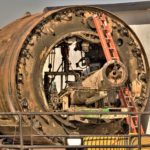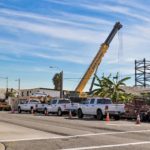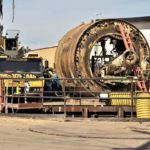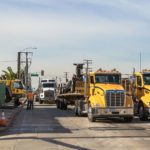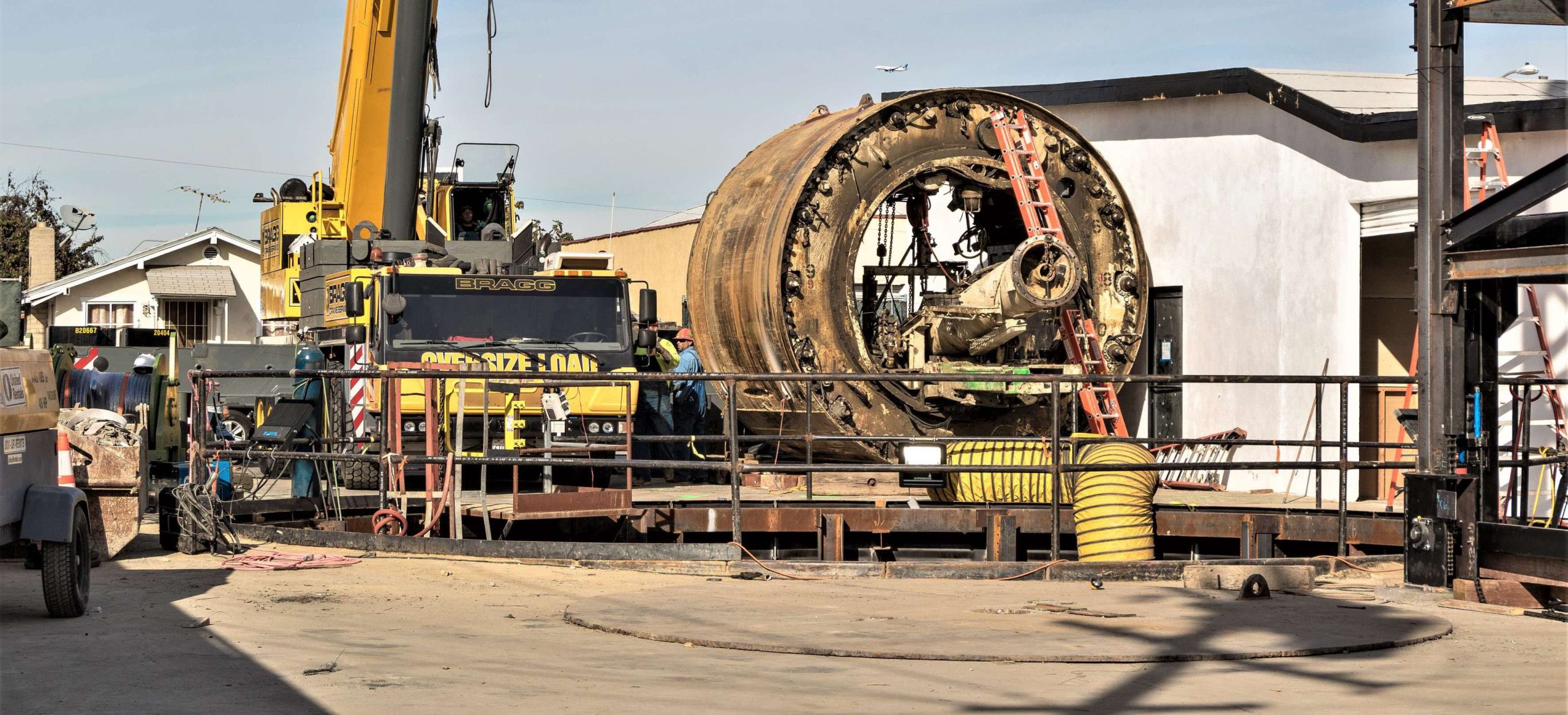
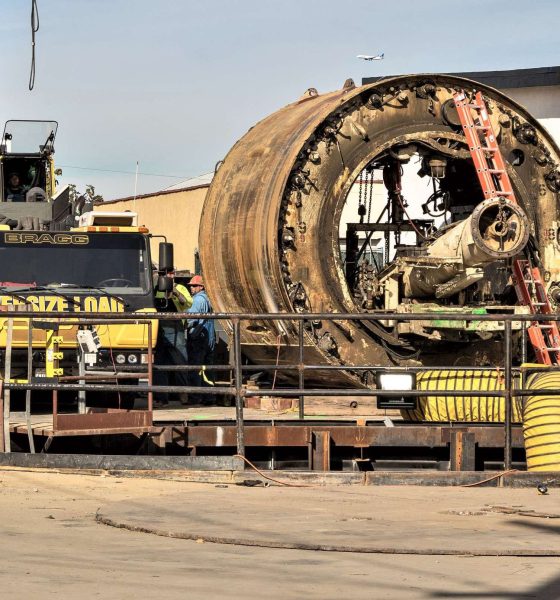
News
Elon Musk’s Boring Company extracts TBM segments as tunnel debut nears
On November 27, a large crew of Boring Company employees and contractors converged upon the company’s Praire Avenue work site, home of a number of recent milestones for the tunneling startup’s 2-mile long test tunnel situated beneath Hawthorne, California. Just a handful of blocks away from SpaceX’s main rocket factory, The Boring Co. completed the removal of its first tunnel boring machine (TBM), allowing the company to begin cleaning up the site, preparing it for the installation of a brand new elevator shaft capable of transporting vehicles or custom sleds into or out of the tunnel.
The extraction of Godot, the tunneling startup’s first TBM, was shared by the company on its official Twitter account. Godot is a conventional TBM, and during the company’s information session earlier this year, Elon Musk noted that the machine would be succeeded by Line-Storm, which is “essentially a hybrid between a conventional boring machine and Proof-Rock, a fully Boring Company-designed machine.” Being electric-powered, Proof-rock is expected have 3x more power and operate 10-15x times faster than Godot.
Godot (our 1st TBM) is out of the ground! Getting excited for Hawthorne test tunnel opening in a few weeks pic.twitter.com/5DF2sDtmIo
— The Boring Company (@boringcompany) November 28, 2018
On the same day as the TBM removal began, news broke that The Boring Company had settled with a number of Los Angeles-based complainants and chosen to cancel a proposed extension of the test tunnel expected to run under Sepulveda Boulevard. Counter to a narrative coming out of several media outlets that TBC had effectively canceled an important tunnel against the company’s will, Elon Musk clarified that the actual explanation for the change in plans was largely positive, with the company believing that it no longer needs additional practice thanks to experience gained through the construction of its first test tunnel.
Instead of pursuing the Sepulveda tunnel extension, The Boring Company instead believes that it can and should move directly to a more ambitious network of tunnels to crisscross subterranean Los Angeles, known as the Dugout Loop thanks to the inclusion of Dodger Stadium as a primary destination.
This is completely backwards. Based on what we’ve learned from the Hawthorne test tunnel, we’re moving forward with a much larger tunnel network under LA. Won’t need a second test tunnel under Sepulveda.
— Elon Musk (@elonmusk) November 29, 2018
Amidst the Boring Company’s preparations for the December 10 opening party of its Hawthorne test tunnel, the site of the Prairie Ave pit, which is expected to be the location of the Boring Company’s prototype garage-elevator concept, has shown lots of activity. Just recently, Teslarati photographer Pauline Acalin was able to capture images of multiple semi-trucks loading and transporting extricated TBM segments.
Based on the photographs we acquired, dozens of employees and/or contractors were present during the TBM extraction. The removal and transportation of the TBM segments from the Prairie Ave. pit appear to have been completed in ~24 hours from start to finish as well, as other members of the Teslarati team who visited the area not long after the photos were taken noted that the boring machine segments have already been transported elsewhere when they arrived.
- The Boring Company began removing Godot, its first tunnel boring machine, on Nov. 27 and completed the removal the following day. (Pauline Acalin)
The Boring Company began removing Godot, its first tunnel boring machine, on Nov. 27 and completed the removal the following day. (Pauline Acalin)
The extraction of Godot from the Prairie Ave. site bodes well for The Boring Company’s planned operations in the future. Conventional tunneling practices, after all, usually involve leaving expensive TBM components such as the cutting head underground after work is complete due to high costs associated with their retrieval. In classic Elon Musk fashion, the Boring Company has opted for reusability instead, seemingly using its prototype garage-elevator concept as an exit point for its TBM segments.
The experience gained by The Boring Company in its Hawthorne test tunnel would help the tunneling startup tackle its most ambitious project to date — Chicago’s upcoming downtown to O’Hare high-speed transport line, which is expected to break ground as soon as the project’s permits are completed. Updates about the Chicago project have been scarce so far, though photographs taken by Teslarati photographers suggest that a gantry for the Chicago tunnel line, as well as what appears to be a next-generation TBM, is under construction.
Here’s a little video we made to commemorate our work covering The Boring Company.

News
Tesla FSD fleet is nearing 7 billion total miles, including 2.5 billion city miles
As can be seen on Tesla’s official FSD webpage, vehicles equipped with the system have now navigated over 6.99 billion miles.

Tesla’s Full Self-Driving (Supervised) fleet is closing in on almost 7 billion total miles driven, as per data posted by the company on its official FSD webpage.
These figures hint at the massive scale of data fueling Tesla’s rapid FSD improvements, which have been quite notable as of late.
FSD mileage milestones
As can be seen on Tesla’s official FSD webpage, vehicles equipped with the system have now navigated over 6.99 billion miles. Tesla owner and avid FSD tester Whole Mars Catalog also shared a screenshot indicating that from the nearly 7 billion miles traveled by the FSD fleet, more than 2.5 billion miles were driven inside cities.
City miles are particularly valuable for complex urban scenarios like unprotected turns, pedestrian interactions, and traffic lights. This is also the difference-maker for FSD, as only complex solutions, such as Waymo’s self-driving taxis, operate similarly on inner-city streets. And even then, incidents such as the San Francisco blackouts have proven challenging for sensor-rich vehicles like Waymos.
Tesla’s data edge
Tesla has a number of advantages in the autonomous vehicle sector, one of which is the size of its fleet and the number of vehicles training FSD on real-world roads. Tesla’s nearly 7 billion FSD miles then allow the company to roll out updates that make its vehicles behave like they are being driven by experienced drivers, even if they are operating on their own.
So notable are Tesla’s improvements to FSD that NVIDIA Director of Robotics Jim Fan, after experiencing FSD v14, noted that the system is the first AI that passes what he described as a “Physical Turing Test.”
“Despite knowing exactly how robot learning works, I still find it magical watching the steering wheel turn by itself. First it feels surreal, next it becomes routine. Then, like the smartphone, taking it away actively hurts. This is how humanity gets rewired and glued to god-like technologies,” Fan wrote in a post on X.
News
Tesla starts showing how FSD will change lives in Europe
Local officials tested the system on narrow country roads and were impressed by FSD’s smooth, human-like driving, with some calling the service a game-changer for everyday life in areas that are far from urban centers.

Tesla has launched Europe’s first public shuttle service using Full Self-Driving (Supervised) in the rural Eifelkreis Bitburg-Prüm region of Germany, demonstrating how the technology can restore independence and mobility for people who struggle with limited transport options.
Local officials tested the system on narrow country roads and were impressed by FSD’s smooth, human-like driving, with some calling the service a game-changer for everyday life in areas that are far from urban centers.
Officials see real impact on rural residents
Arzfeld Mayor Johannes Kuhl and District Administrator Andreas Kruppert personally tested the Tesla shuttle service. This allowed them to see just how well FSD navigated winding lanes and rural roads confidently. Kruppert said, “Autonomous driving sounds like science fiction to many, but we simply see here that it works totally well in rural regions too.” Kuhl, for his part, also noted that FSD “feels like a very experienced driver.”
The pilot complements the area’s “Citizen Bus” program, which provides on-demand rides for elderly residents who can no longer drive themselves. Tesla Europe shared a video of a demonstration of the service, highlighting how FSD gives people their freedom back, even in places where public transport is not as prevalent.
What the Ministry for Economic Affairs and Transport says
Rhineland-Palatinate’s Minister Daniela Schmitt supported the project, praising the collaboration that made this “first of its kind in Europe” possible. As per the ministry, the rural rollout for the service shows FSD’s potential beyond major cities, and it delivers tangible benefits like grocery runs, doctor visits, and social connections for isolated residents.
“Reliable and flexible mobility is especially vital in rural areas. With the launch of a shuttle service using self-driving vehicles (FSD supervised) by Tesla in the Eifelkreis Bitburg-Prüm, an innovative pilot project is now getting underway that complements local community bus services. It is the first project of its kind in Europe.
“The result is a real gain for rural mobility: greater accessibility, more flexibility and tangible benefits for everyday life. A strong signal for innovation, cooperation and future-oriented mobility beyond urban centers,” the ministry wrote in a LinkedIn post.
News
Tesla China quietly posts Robotaxi-related job listing
Tesla China is currently seeking a Low Voltage Electrical Engineer to work on circuit board design for the company’s autonomous vehicles.

Tesla has posted a new job listing in Shanghai explicitly tied to its Robotaxi program, fueling speculation that the company is preparing to launch its dedicated autonomous ride-hailing service in China.
As noted in the listing, Tesla China is currently seeking a Low Voltage Electrical Engineer to work on circuit board design for the company’s autonomous vehicles.
Robotaxi-specific role
The listing, which was shared on social media platform X by industry watcher @tslaming, suggested that Tesla China is looking to fill the role urgently. The job listing itself specifically mentions that the person hired for the role will be working on the Low Voltage Hardware team, which would design the circuit boards that would serve as the nervous system of the Robotaxi.
Key tasks for the role, as indicated in the job listing, include collaboration with PCB layout, firmware, mechanical, program management, and validation teams, among other responsibilities. The role is based in Shanghai.
China Robotaxi launch
China represents a massive potential market for robotaxis, with its dense urban centers and supportive policies in select cities. Tesla has limited permission to roll out FSD in the country, though despite this, its vehicles have been hailed as among the best in the market when it comes to autonomous features. So far, at least, it appears that China supports Tesla’s FSD and Robotaxi rollout.
This was hinted at in November, when Tesla brought the Cybercab to the 8th China International Import Expo (CIIE) in Shanghai, marking the first time that the autonomous two-seater was brought to the Asia-Pacific region. The vehicle, despite not having a release date in China, received a significant amount of interest among the event’s attendees.
